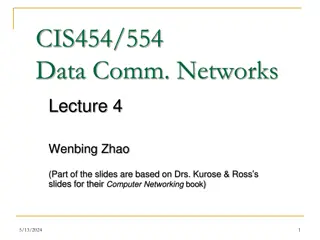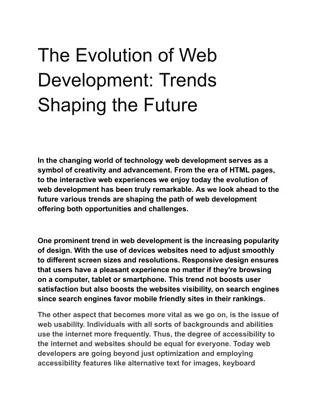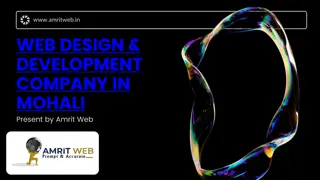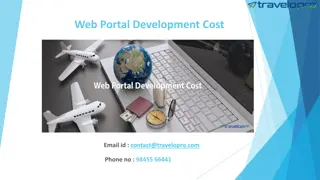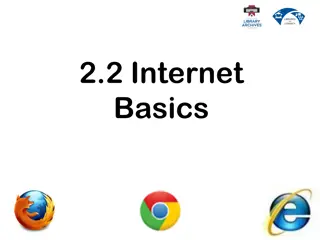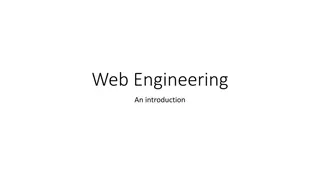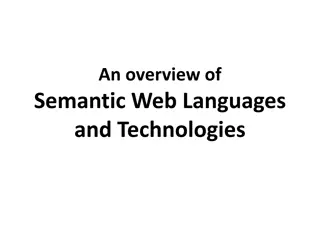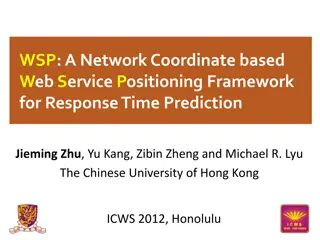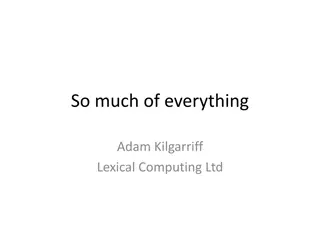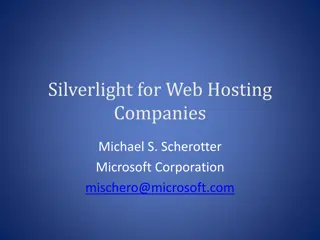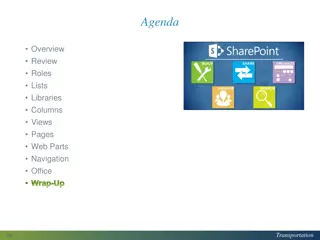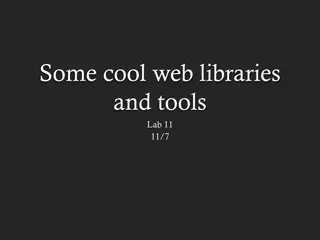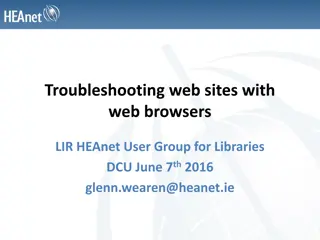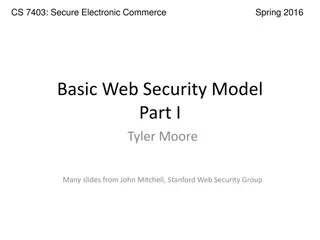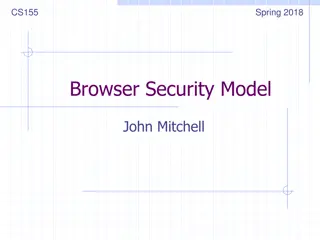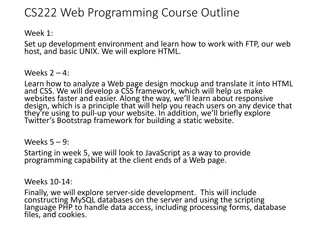
Web Infrastructure by Dr. Nicholas Gibbins
Explore insights on open hypermedia and the web, the significance of hypertext, linkbase creation, and link injection in web infrastructure. Learn about past technologies and potential advancements for enhancing user experience and information retrieval on the web.
Download Presentation

Please find below an Image/Link to download the presentation.
The content on the website is provided AS IS for your information and personal use only. It may not be sold, licensed, or shared on other websites without obtaining consent from the author. If you encounter any issues during the download, it is possible that the publisher has removed the file from their server.
You are allowed to download the files provided on this website for personal or commercial use, subject to the condition that they are used lawfully. All files are the property of their respective owners.
The content on the website is provided AS IS for your information and personal use only. It may not be sold, licensed, or shared on other websites without obtaining consent from the author.
E N D
Presentation Transcript
Open Hypermedia and the Web COMP3220 Web Infrastructure Dr Nicholas Gibbins nmg@ecs.soton.ac.uk
There is no runner-up prize If Microcosm and Hyper-G were so good, why are we not all using them? 3
Open Hypertext on the Web We lost the goal of hypertext across the entire desktop is this still important? 4
Open Hypertext on the Web HTML and DOM by themselves do not allow easy control of anchor positions Still possible to separate links and annotations Linkbase creation Link injection Link presentation 5
Linkbase creation Manual creation of links is possible (also desirable?), but time-consuming Automatic creation of links based on natural language information extraction 1. Extract key phrases/themes from documents based on location and frequency 2. Create generic links to those documents based on the extracted themes 3. Use interactive linkbase editor to delete unwanted links Effectively turning a search engine index into a linkbase 6
Link injection How do we add links into representations? Where/when do we add links into representations? batch process documents in origin server in proxy server in user agent 7
Link injection: batch processing Generate static HTML pages for use with any web server Fastest way to serve pages - and most cache friendly approach Need to reprocess pages in the event of a linkbase update No opportunity to personalise content 8
Link injection: on demand in the origin server Careful choice of data structures and algorithms needed to ensure good performance New material can immediately be viewed with hyperlinks from the linkbase User can choose linkbases to apply (stateful interaction) Higher run-time memory requirements, search capability can use same data Approach taken by Active Navigation (commercial successor to Microcosm) 9
Link injection: using a proxy server User configures their browser to proxy through the link injector Can apply link database to almost any content Can also perform other conversions e.g. Word -> HTML Casual site users won t want to reconfigure their browsers Approach taken by the Dynamic Link Service (DLS) 10
Link injection: in the user agent Extend browser with a plugin that fetches links and rewrites documents Most modern browsers support add-on functionality Potentially expensive need to provide plugins for many browsers Approach taken by COHSE/Magpie 11
Link Presentation Distinguish third-party (i.e. linkbase) links from authored (i.e. embedded) links Use different colours (etc) Consistent presentation across representations with variable styling Presentation of n-ary links and overlapping anchors: pop-up menus, interstitial pages History of unsuccessful attempts Microsoft Smart Tags in Office XP Third-party embedded advertising links (Infolinks, IntelliTXT, Vibrant) 12
Limitations of HTML linking Addressing URIs for identifying whole resources Elements with name or id attributes for identifying resource fragments Closed tag set (<a>, <img>, etc) Fixed link traversal semantics Single-ended, unidirectional, embedded No stylesheet (or similar) to express link semantics Lorem ipsum dolor sit amet, consectetur adipiscing elit. Nulla consequat tortor eget turpis scelerisque sit amet facilisis metus iaculis. Duis aliquam lacinia dictum. Morbi commodo bibendum ligula, et lobortis diam varius non. Morbi ac elit leo, ac semper nunc. Can we do better using Web standards? 14
XPath XPath provides path expressions for addressing nodes within an XML parse tree We ve used it so far to apply templates in XSLT We could use it instead to specify the anchor of a link endpoint (i.e. as a locspec) Robie, J. et al (2017) XML Path Language (XPath) 3.1. W3C Recommendation. Available at: https://www.w3.org/TR/xpath-31/ 15
XPath abbreviated path expressions Selects all children of the context node * E Selects all E element children of the context node E[@att=val] Selects all E element children whose att attribute has a value of val Selects the nth E element child of the context node E[n] text() Selects the text node children of the context node id("x") Selects the element with id of x (i.e. the id attribute in HTML) / Selects from the root node // Selects nodes anywhere under the context node . Selects the context node .. Selects the parent of the context node 16 16
XPath path expression examples //main/p[1] //p[@class="warning"] Selects the first paragraph in the main element //footer/h2[text()="References"] Selects all paragraphs whose class attribute has the value warning Selects all h2 elements in footers whose text is References //a[starts-with(@href,"/"]/text() Selects the text content of all a elements whose hrefattribute starts with / //id("chapter1") Selects the element with id "chapter1" 17 17
XPath and referential Integrity XPath allows us to address arbitrary elements in an XML parse tree Resulting addresses may not be robust when the resource representation changes Consider the difference between the following: //id("chapter1") //main/section[1]/p[3]/span After editing, the path expression using id() is still likely to work The second path expression may not point to the same part of the document 18
XPointer XPath has some limitations: Can't identify arbitrary ranges within a document, only elements Doesn't identify which document the path is to be applied to The XPointer framework allows XPath path expressions to be used as fragment identifiers in URIs http://example.org/#xpointer(//main/section[1]/p[3]/span) Intended to be used with format-specific schemes Default scheme xpointer() is designed for use with XML-based languages 19 Grosso, P. et al (2003) XPointer Framework. W3C Recommendation. Available at: https://www.w3.org/TR/xptr-framework/
XPointer ranges The xpointer() scheme extends XPath to include ranges in XML documents: xpointer(string-range(//p,"squeamish ossifrage")) Indicates the string "squeamish ossifrage" in any p element Generic links! xpointer(id("chapter1")/range-to(id("section1.1"))) Indicates the portion of the document lying between the elements with ids "chapter1" and "section 1.1" DeRose, S. et al (2002) XPointer xpointer() Scheme. W3C Working Draft. Available at: https://www.w3.org/TR/xptr-xpointer/ 20
XLink Generic framework for representing links in XML documents Used to define XML formats for linking element names are arbitrary Distinguishes between simple links and extended links Simple link: a link which associates exactly two resources, one of which is local (equivalent to an embedded HTML link using the <a> element) Extended link: a link which associates an arbitrary number of resources (i.e. a first-class link) Defines a set of XML attributes which may be added to markup: xlink:type, xlink:href, xlink:role, xlink:arcrole, xlink:title, xlink:label, xlink:show, xlink:actuate DeRose, S. (2010) XML Linking Language (XLink) Version 1.1. W3C Recommendation. Available at: https://www.w3.org/TR/xlink11/ 21
Anatomy of an XLink link Links in Xlink are slightly different to other first-class links Links are collections of resources (resource endpoint) Local resources (i.e. textual anchor for an embedded link) Remote resources specified by a locator (i.e. URI including optional fragment) text Links contain arcs which specify pairs of endpoints which may be traversed remote resources local resource 22 22
XLink simple links <link xlink:href="http://example.org/">some text</link> Note that link element name is not part of XLink. xlink:type attribute is optional on simple links, arc is implicit. some text 23
XLink extended links Consider an extended link version of the simple link on the previous slide: <link xlink:type="extended"> <anchor xlink:type="resource" xlink:label="source">some text</resource> <location xlink:type="locator" xlink:label="destination" xlink:href="http://example.org/"/> <transition xlink:type="arc" xlink:from="source" xlink:to="destination"> </link> xlink:label used to identify resources for use in arcs 24
XLink bidirectional first-class link https://a.example.org/ <link xlink:type="extended"> <location xlink:type="locator" xlink:label="end1" xlink:href="http://a.example.org/"/> <location xlink:type="locator" xlink:label="end2" xlink:href="http://b.example.org/"/> <transition xlink:type="arc" xlink:from="end1" xlink:to="end2"> <transition xlink:type="arc" xlink:from="end2" xlink:to="end1"> </link> https://b.example.org/ 25
XLink behaviours Two orthogonal behaviours of links: Is a link traversed automatically, or must it be a deliberate act by the user? xlink:actuate="onLoad" Automatically actuate the link when the page loads Behaves like the HTML img element xlink:actuate="onRequest" Only actuate the link when the user requests Behaves like the HTML a element 26
XLink behaviours Two orthogonal behaviours of links: Is a link traversed automatically, or must it be a deliberate act by the user? In what context is the link destination displayed? xlink:show="replace" Display the destination in the current context (default behaviour of the HTML a element) xlink:show="new" When traversing the link, display the destination in a new context (i.e. window, browser tab) Behaves like the HTML a element with target="_blank" xlink:show="embed" Display the destination by embedding it in the current context Behaves like the HTML img element 27
XLink roles and titles More general version of rel/rev attributes in HTML xlink:role used to express link type (i.e. meaning of a link as a whole) xlink:arcrole used to express the meaning of a specific arc within a link Both take URIs as values (compare with simple keywords used as link types in HTML) xlink:title attribute used to provide human-readable labels Used for extended links, arcs and locators Can also use an element with xlink:type="title" to specify labels 28
Defining XLink vocabularies Use DTDs/XML Schema to simplify use of XLink: <!ELEMENT link ((location|anchor|transition)*)> <!ATTLIST link xmlns:xlink CDATA #FIXED "http://www.w3.org/1999/xlink" xlink:type (extended) #FIXED "extended"> <!ELEMENT location EMPTY> <!ATTLIST location xlink:type (locator) #FIXED "locator" xlink:href CDATA #REQUIRED xlink:label NMTOKEN #REQUIRED> <!ELEMENT anchor ANY> <!ATTLIST anchor xlink:type (resource) #FIXED "resource" xlink:label NMTOKEN #REQUIRED> <!ELEMENT transition EMPTY> <!ATTLIST transition xlink:type (arc) #FIXED "arc" xlink:from NMTOKEN #REQUIRED xlink:to NMTOKEN #REQUIRED> 29
Using XLink vocabularies Consider the bidirectional link from earlier in this lecture: <link> <location xlink:label="end1" xlink:href="http://a.example.org/"/> <location xlink:label="end2" xlink:href="http://b.example.org/"/> <transition xlink:from="end1" xlink:to="end2"> <transition xlink:from="end2" xlink:to="end1"> </link> https://b.example.org/ https://a.example.org/ 30
Further reading DeRose, S. et al (2010) XML Linking Language (XLink) Version 1.1. W3C Recommendation https://www.w3.org/TR/xlink11/ Grosso, P. et al (2003) XPointer Framework. W3C Working Draft. https://www.w3.org/TR/xptr-framework/ Robie, J. et al (2017) XML Path Language (XPath) 3.1. W3C Recommendation https://www.w3.org/TR/xpath-31/ 31

